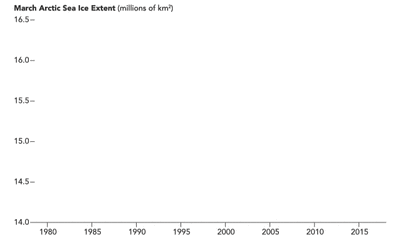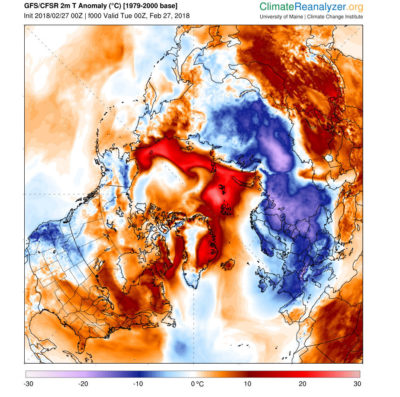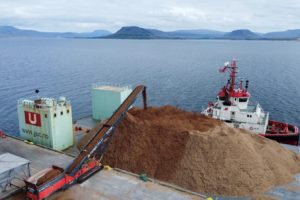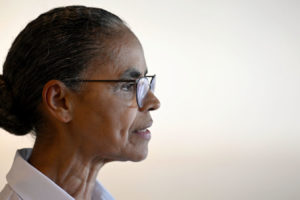While the eastern United States and large parts of Europe suffered through a long, cold winter, temperatures were nothing short of balmy over much of the Arctic. The North Pole experienced above-freezing weather in February, temperatures over the Arctic Ocean were as much as 13 degrees Fahrenheit above average from December into early March, and sea ice melted back to its second-lowest annual maximum extent since the satellite record began in 1979.
For Mark Serreze, director of the National Snow and Ice Data Center, these Arctic heat waves have become depressingly routine. First, there was year after year of high summer temperatures and melting sea ice. Now, in the past few years, winter itself has been faltering over the once-frozen Far North. “What’s happening over the past four winters with these heat waves, I have never seen anything like it in my life,” says Serreze, a geographer and sea ice expert who has worked in the Arctic for 36 years.
In an interview with Yale Environment 360, Serreze discusses how he and his colleagues gradually began to accept that human carbon emissions were radically altering the Arctic; talks about the huge environmental, cultural, and geopolitical implications of a warming Arctic; and describes the shock of witnessing the stunning transformation of the region in his professional lifetime. “The thing is, when you’re thinking about the Arctic, the Arctic’s soul is its ice,” says Serreze, author of the new book Brave New Arctic: The Untold Story of the Melting North. “When you lose that ice, the Arctic loses its soul.”
Yale Environment 360: At what point did scientists really start noticing that the Arctic was changing and accept that it wasn’t a natural phenomenon, but a human driven one?
Mark Serreze: It took a while. It was definitely in fits and starts. Where the Arctic first started to stir, you might say, was in the ocean. There were these observations coming in 1991 – this German oceanographer, Detlef Quadfasel, noticed this slight warming of the Arctic Ocean. No one was quite sure what to think about it. Then, more evidence started to come in that year and the sea ice looked like it was starting to decline. We were seeing warming over some parts of the Arctic, although it was cooling over other parts of it. Things were starting to change a little bit. It looked a lot like just natural variability in climate — at least that’s what it looked like to me.
Through the mid-1990s, even late-1990s, it became increasingly clear that while things were really changing in the Arctic, you didn’t necessarily have to invoke the specter of greenhouse gases to really explain this. It looked like natural variability. It was probably for me not until around 2003 that the weight of evidence became so overwhelming, that we were seeing the Arctic respond to the rise in greenhouse gases, that I had no recourse but to say, “Okay, it’s here, and it’s now.”
e360: Is there one particular change or one particular set of data or observations that finally convinced you that this was happening?
Serreze: No. Not at all, actually. It was the cumulative weight of everything. We saw the sea ice decreasing. One might say, maybe just weather patterns are doing that, or maybe there’s a problem with the record. Then you look at the air temperature record and things were clearly warming up very strongly. Then you look at things like the temperature of permafrost. Then at the changes occurring in the Arctic landscape, where you see treeless windswept tundra being taken over by shrubs.
“You get to the coast of the Beaufort Sea and you look north, and in September, all you see is ocean when there should be sea ice.”
Any one of these pieces of evidence you might be able to question, but not when you put them all together and look at them as a whole. That’s what really turned me. It was looking at the whole body of evidence and what it was saying. There was just no question anymore.
e360: What are some of the most alarming changes that have taken place?
Serreze: From my perspective, the most alarming thing is the loss of the Arctic sea ice cover. We see the sea ice decreasing in all months of the year, but most pronounced in summer, specifically at the end of summer, September, at the end of the melt season. It’s something like 13 percent per decade. It’s a remarkable decline.
What the satellite data doesn’t necessarily give you is the real visual perspective. You get to the coast of the Beaufort Sea and you look north, and in September all you see is ocean when there should be sea ice. That’s the visual stuff that is pretty visceral.
e360: When do scientists think that the Arctic Ocean will likely be ice free in summer, and how has this timeline shifted over the past decade?
Serreze: It was somewhere around the turn of the century that we first started to realize that if things continued along the path they were on, an ice-free Arctic Ocean in summer was probably inevitable. Then along came 2007 — this record low sea ice [year], which blew away all previous records. It was this huge wake-up call.
That event was something that led to a whole lot of subsequent studies about when we’re going to lose that [summer] sea ice. I am on record saying as early as 2030, and I’ll stand behind that. The numbers are coming in now of sometime in the mid-2040s. That seems to be where a lot of scientists are starting to converge upon, but it could be later or it could be earlier than that.
Since 1979, Arctic sea ice extent in March, when the annual maximum is recorded, has declined of 2.7 percent per decade. National Snow and Ice Data Center
e360: This year, the region’s winter sea ice was the second-lowest on record. Why is it so significant that we’re seeing winter sea ice also declining? And how do the conditions this past winter fit into the context of the last few decades of warming?
Serreze: When we look at what’s happening to the sea ice cover, most of the attention has been paid to that end-of-summer number. What you’ve seen lately is this recognition that things are really happening in the winter now. Winter’s really gotten into the act here. The four lowest winter ice extents at the seasonal maximum, which occurs sometime in March, have all occurred in the past four years. It’s hastening that glide towards a seasonally ice-free Arctic Ocean.
Not only that, we’ve been seeing over the Arctic Ocean in winter these unprecedented heat waves, things we’ve never seen before. Like on New Year’s Day and over the North Pole, it’s at the melting point. That’s not supposed to happen… [These warming events] are associated with crazy jet stream patterns in the atmosphere. It’s bringing in all this heat from lower latitudes way up into the Arctic. That is working against forming sea ice in the winter. It’s part and parcel of these very low winter sea ice maximums we’ve been seeing.
What’s happening over the past four winters with these heat waves, I have never seen anything like it in my life.
e360: If we lose that summer sea ice and if winter ice keeps declining, why does that matter?
Serreze: First of all, there are all these within-Arctic impacts. If you’re living up there, along the Beaufort Sea coast, one of the things you’re experiencing is coastal erosion. You have some areas where the coast is eroding back 30 feet per year. You may have heard of the village of Shishmaref, Alaska; they have to move it because it’s eroding into the sea. You also have the loss of ice impacting indigenous hunting practices.
“As we lose the ice cover, the Arctic becomes more accessible. So does mineral wealth, oil, and natural gas at the bottom of the Arctic Ocean.”
There’s the impact on things like polar bears and other mammals that live on the ice. Then, there’s the geopolitical scene. As we lose the ice cover, the Arctic becomes more accessible. So does mineral wealth, oil, and natural gas at the bottom of the Arctic Ocean. If the prices are right, someone’s going to go after it. The Russians are all over this, developing those resources. Royal Dutch Shell went up there a few years ago. They said they were disappointed in what they found in the Chukchi Sea, but prices were low then. They’ll be back if prices are high.
You’re seeing increases in tourism in the Arctic. The last two summers, the Crystal Serenity, this huge luxury liner, sailed through the Northwest Passage. Roald Amundsen was the first [to traverse the Northwest Passage] way back in 1902; it took him two-and-a-half years to do it. Now, the Crystal Serenity goes through there in a week.
The other concerns are the environmental impacts. Number one, there’s this issue of what we call a permafrost/carbon feedback. There is all this carbon locked up in permafrost and as we warm up the Arctic, that permafrost thaws, the microbes in the soil become active, they start eating the carbon, releasing carbon dioxide or methane into the atmosphere, increasing the atmospheric load of greenhouse gases, furthering the warming.
Temperatures in the Arctic averaged 5.1 degrees Celsius above than the 1979-2000 average on February 27, with some areas measuring as high as 20 degrees C above average. Climate Reanalyzer
The other thing is this idea that if we warm up the Arctic, that can influence the jet stream patterns and influence weather patterns in the middle latitudes. This gives rise to these stuck weather patterns, where someplace like Chicago is in a deep freeze while at the same time, it’s so warm in Alaska that they have to move the start of the Iditarod [dogsled race].
e360: Why do you think that up until now, media coverage and scientific communication have had little effect on conveying a sense of urgency to the public and politicians about the climate crisis?
Serreze: I wish I knew. Climate change has become such a political football, it’s become so polarized that it is seemingly impossible to make progress on things. As a society, we seem to be very shortsighted. There are those of us who say, “Hey, look, we need to worry about the future.” It seems that within our political system and economic system, we just look at the short term.
I’ve long stated that we should be able to have separate discussions about the science of climate change and what we should do about it. The science of climate change, no matter what some say, is solid. Rock solid. Now, what should we do about it? There’s ample room for discussion about that. We’ve got to have energy. We have to be pragmatic. We have to make sensible choices here. Ignoring this, we do it at our peril. I wish we could separate these things, but we can’t. They get unfortunately highly intertwined.
“There’s been studies showing that if you could cool the climate down again, the sea ice in the Arctic would actually recover fairly quickly.”
e360: In your new book, you write that in the Arctic, “the forces of change seem to be unstoppable.” Do you really believe that?
Serreze: I think we’re destined for a seasonally ice-free Arctic Ocean right now. I don’t think we can stop that. There is too much heat in the pipeline already… and we are still very highly dependent on fossil fuels. Those greenhouse gas levels are going to continue to rise. Now, that does not mean [sea ice loss] cannot be reversed. In fact, there have been studies showing that if you could cool the climate down again, the sea ice in the Arctic would actually recover fairly quickly.
e360: What has it been like on a personal level watching this environment change over the course of your career?
Serreze: It’s frankly shocking… When you look at the Arctic, see what’s happened, you can watch it change before your eyes. That’s what I’ve done. When I first went up into the Arctic in 1982, I had no idea at all that we’d ever see something like this. Now, only 36 years later, and the Arctic of old is gone.
e360: If the region has changed this radically before your eyes in a mere 36 years, what do you expect it to look like at the end of this century?
Serreze: We’re going to have an Arctic that, except for winter, you look at it from satellite and it’s going to be a blue ocean. It will have lost its ice. Not just its sea ice, but a lot of the permafrost will be thawed, the snow cover season will be much shorter. The thing is, when you’re thinking about the Arctic, the Arctic’s soul is its ice. When you lose that ice, the Arctic loses its soul.






